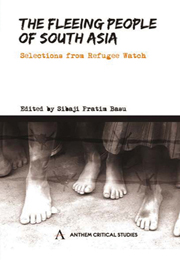Book contents
- Frontmatter
- Contents
- Acronyms and Abbreviations
- Foreword by Ranabir Samaddar
- Preface
- ETHICAL ISSUES
- LAWS
- SOUTH ASIA
- INDIA
- Introduction
- Population Displacement in India: A Critical Overview
- Reporting from Gagan Geer: A Kargil War Refugee Camp
- Barricaded Kashmiri Pandits Letting Go the Right to Return?
- Homeless and Divided in Jammu and Kashmir
- Internal Displacement in North-East India: Challenges Ahead
- The North-East Today: Displacing Identities, Displaced Identities
- Tibetan Refugees in India: Surviving in Exile
- Unrest and Displacement: Rajbanshis in North Bengal
- Adivasis in Coal Mining
- GENDER
- INTERVIEW/CORRESPONDENCE
- REPRESENTATIONS
- Index
Introduction
from INDIA
Published online by Cambridge University Press: 05 March 2012
- Frontmatter
- Contents
- Acronyms and Abbreviations
- Foreword by Ranabir Samaddar
- Preface
- ETHICAL ISSUES
- LAWS
- SOUTH ASIA
- INDIA
- Introduction
- Population Displacement in India: A Critical Overview
- Reporting from Gagan Geer: A Kargil War Refugee Camp
- Barricaded Kashmiri Pandits Letting Go the Right to Return?
- Homeless and Divided in Jammu and Kashmir
- Internal Displacement in North-East India: Challenges Ahead
- The North-East Today: Displacing Identities, Displaced Identities
- Tibetan Refugees in India: Surviving in Exile
- Unrest and Displacement: Rajbanshis in North Bengal
- Adivasis in Coal Mining
- GENDER
- INTERVIEW/CORRESPONDENCE
- REPRESENTATIONS
- Index
Summary
India is generally considered as a generous host to the refugees compared to her neighbouring states. But, there is hardly any place for complacence. In recent years, government policies have become more stringent and discouraging. This is evident in the case of Sri Lankan Tamils (particularly after the assassination of former Prime Minister Rajiv Gandhi) and also in the case of Bhutanese refugees of Nepalese origin, who had been detained and then sent back to Nepal. It is time to review the situation of the external shelter seekers in India. But equal, if not more attention must be devoted to the alarmingly increasing number of Internally Displaced Persons (IDPs) in India, who have lost their homes on various accounts.
Samir Das and Sabyasachi Basu Ray Chaudhury in a very useful article seek to fill this gap, at least conceptually. In ‘Population Displacement in India: A Critical Overview’, they propose a very important ‘Typology of Internal Displacement’, which is immensely helpful, especially for beginners: both academics and activists. The authors classify this phenomenon into five broad categories and hold insightfully: ‘The fact that some communities are perpetually vulnerable to displacement than some others speaks of a deep – yet undeclared divide within the Indian society between the so-called “nationalist mainstream” and the outside’.
- Type
- Chapter
- Information
- The Fleeing People of South AsiaSelections from Refugee Watch, pp. 225 - 228Publisher: Anthem PressPrint publication year: 2009



